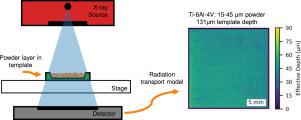Additive Manufacturing ( IF 11.0 ) Pub Date : 2021-07-27 , DOI: 10.1016/j.addma.2021.102197 Ryan W. Penny 1 , Patrick M. Praegla 2 , Marvin Ochsenius 2 , Daniel Oropeza 1 , Reimar Weissbach 1 , Christoph Meier 2 , Wolfgang A. Wall 2 , A. John Hart 1

|
Uniform powder spreading is a requisite for creating consistent, high-quality components via powder bed additive manufacturing (AM), wherein layer density and uniformity are complex functions of powder characteristics, spreading kinematics, and mechanical boundary conditions. High spatial variation in particle packing density, driven by the stochastic nature of the spreading process, impedes optical interrogation of these layer attributes. Thus, we present transmission X-ray imaging as a method for ex situ mapping of the effective depth of model powder layers at process-relevant scale and resolution. Specifically, we study layers of nominal 50–250 m thickness, created by spreading a selection of commercially obtained Ti-6Al-4V, 316 SS, and Al-10Si-Mg powders into precision-depth templates. We find that powder layer packing fraction may be predicted from a combination of the relative thickness of the layer as compared to mean particle size, and flowability assessed by macroscale powder angle of repose. Power spectral density analysis is introduced as a tool for analyzing layer uniformity in the spatial frequency domain. This approach enables quantitative analysis of deposition irregularities, along with separate consideration of layer uniformity and sparsity. Finally, spreading is studied using multi-layer templates, providing insight into how particles interact with both previously deposited material and abrupt changes in boundary condition. Experimental results are additionally compared to a purpose-built discrete element method (DEM) powder spreading simulation framework, clarifying the competing role of adhesive and gravitational forces in layer uniformity and density, as well as particle motion within the powder bed during spreading.
中文翻译:

通过透射 X 射线成像对金属增材制造的粉末层密度进行空间映射
均匀的粉末铺展是通过粉末床增材制造 (AM) 创建一致、高质量组件的必要条件,其中层密度和均匀性是粉末特性、铺展运动学和机械边界条件的复杂函数。由扩散过程的随机性质驱动的粒子堆积密度的高空间变化阻碍了对这些层属性的光学询问。因此,我们将透射 X 射线成像作为一种以工艺相关的尺度和分辨率对模型粉末层的有效深度进行非原位映射的方法。具体来说,我们研究了标称 50-250 米厚度,通过将精选的商业获得的 Ti-6Al-4V、316 SS 和 Al-10Si-Mg 粉末散布到精确深度模板中来创建。我们发现粉末层堆积率可以通过与平均粒径相比的层的相对厚度和通过宏观粉末休止角评估的流动性的组合来预测。引入功率谱密度分析作为分析空间频域中层均匀性的工具。这种方法可以对沉积不规则性进行定量分析,同时单独考虑层的均匀性和稀疏性。最后,使用多层模板研究扩散,深入了解粒子如何与先前沉积的材料相互作用以及边界条件的突然变化。


























 京公网安备 11010802027423号
京公网安备 11010802027423号